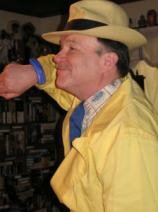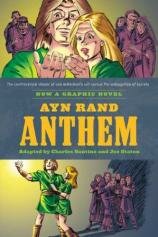A Good Joe: Joe Staton
Joe Staton is one of the true greats of the comics industry, a legend who’s been in the business for decades and illustrated almost every character imaginable. Now he’s back illustrating the new book Anthem, an adaptation of Ayn Rand’s book done in conjunction with writer Charles Santino. We interviewed Joe about his long history in the business, how the industry has changed, and how he views it now.
You started in this industry at a very young age—in your early 20s. How did you break in?
I guess I was about 21 or so. I’d been taking samples around to Marvel and DC and not getting anywhere. I took samples into Charlton and got work on the ghost stories. And I’ve had fun working from there on!
What do you remember most about starting out? What was the industry like back then?
I was coming along just kind of at the time that the next generation of guys, like Bernie Wrightson and people like that, were breaking in. Kind of establishing things at DC, I guess. It was kind of the time of Jim Starlin. I was a little behind those guys. I came along from Charlton, but it was a time when I guess the house style was breaking up just a bit. So I was around at the turn of things.
Your look is very distinctive, and it’s an art style I’ve always loved. What influenced that?
Well, everything I’ve looked at forever. [Laughs] Chester Gould was my first influence, Jack Cole—certainly a lot of that. And Steve Ditko, Gil Kane, Al Capp,Mad Magazine. I was always on the edge between the adventure stuff and the funny stuff. I guess I’m kind of a mix of all of it.
Back when you started, art in comics conveyed a lot more story on every page, and the writing and artwork had to work together. There were far more words on a page, and far more panels per page in mainstream comics.
We had to get more on a page then. And most of the things were full script, so you had to allow for the word balloons. That was something I had trouble getting the hang of to start with. Every once in a while, you’d have a balloon crossing Superman’s chest or something like that. [Editor] Julie Schwartz yelled at me a lot about that, but I think I eventually got the hang of it. We had a lot of talking on the pages and a lot of information on a page. We had to keep things clear and keep it moving.
What did you have to do to adapt your work to comics in that sense?
Well, mostly, it was just after a while you kind of get the feeling for it. The first guy who’s talking has to be standing in a prominent position, and then you move people around from there on. You start treating the balloons as part of the design, so it’s not just drawing, it’s setting up all of the copy as well.
You’ve worked with a lot of different inkers throughout your career. Does anyone stand out as someone whose work really complemented yours the best?
There have been several. I had a real good run on Green Lantern with Bruce Patterson. I’ve always thought that Bruce made my stuff look real solid, like it was really there. And I did some Batman work with Horacio Ottolini from Argentina who’s really good and brought a lot to my stuff. Way back when, I did Plastic Man with Bob Smith and he just inked some Archie stuff of mine. I always liked what he did. There have been a lot of inkers I’ve worked with who are good.
You’ve also been an artist on my favorite comic book of all time, like Superboy and Legion, and you worked on a lot of Earth-2 stories for DC. Do you have good memories of that time?
Well, that would have been with Paul Levitz and Jack Abel. I always thought my stuff on Legion worked well with those guys. I always liked working with Paul. I could always get a hang on his characters, whether it was The Huntress or the Legion or any of the JSA. And Jack Abel, when he was inking my Legion stuff, I thought it looked really good. He made it look designy and sharp. It was a completely different look from other people. He did a really nice job.
Were you sad when Earth-2 was dissolved during Crisis and are you happy it’s back?
Well, I’m never sure what the current reality is or who’s alive or whatever. But I’m certainly glad to see the old characters coming back around.
Speaking of old characters, now you’re doing Dick Tracy. How did that come about?
I just always wanted to draw Dick Tracy. It was kind of a secret that artist Dick Locher was thinking about retiring, and the people at the Tribune were looking around figuring out what to do. I’ve had several times I’ve had Dick Tracy stuff online, and I had a character in Femme Noir, a webstrip I did, who was based on Tracy. Whenever I’ve done an interview and people have asked me what would I most like to do, I always have Dick Tracy right up there at the top. So when it came around, they asked and I was ready to go.
What are some things coming up in the strip that you can reveal?
Oh, golly. I’m not sure what I can reveal. They’re being very strict on what we can say. I guess the basic things I can say are that it’s going to be classic, we’re bringing back a lot of classic characters and classic situations, but we’re also introducing some new stuff, new characters. One of our first new villains is suggested by a cable cooking character. I’ll leave it at that. We’re kind of mixing old and new stuff, and it’s fun.
Visually, how do you approach it?
Well, like I said, Chester Gould is my first influence. My mother told me that they had found me on the floor when I was three years old trying to trace Dick Tracy. So I figure that’s my first influence and whatever I do with Tracy, it’s going to draw on Chester Gould, so it’s not like I’m trying to really copy anything that Gould or Fletcher or anyone did before me. But there’s so much influence that I’m hoping that I can pick at and find that in my brain somewhere and it will all just come together. One thing is when I really became aware of Tracy it was like the early ’50s, that period. Looking back on it, that’s my favorite period of Chester Gould’s work. I do look back on that period and try to draw current things that are consistent with the way he was drawing back then. In some ways, I’m kind of a very conservative approach to the material but I’m still trying to get all that goofiness, that exaggeration.
How did you get involved with Anthem and writer Charles Santino?
I’ve known Charles quite a while. He packages material and we’ve had things we’ve put together and shopped around at various times. Some of our own material as well as adaptations. Somehow he became aware that Anthem could have actually been adapted by anybody at anytime because the rights weren’t clear in the States, but he approached the Rand Institute on the possibility of him packaging it, found the publisher, and got authorized to do it. So he contacted me and said, Hey, this is a book that everybody in the entire country has to read in high school, so they might like a graphic-novel version. He put it together and he brought me in, and that’s how I wound up doing it.
Were you an Ayn Rand reader before this?
I really don’t know that much about Ayn Rand’s work. I’m basically a fan ofClassics Illustrated and I did A Christmas Carol for First Comics when they were doing Classics Illustrated. I read Classics Illustrated for years and years, and I was working on an adaptation of Voltaire’s Candide when they shut down. It’s one of those things that I’ve always really liked to do, take things from one medium and work them into comics. I could see there was a story there that would make good comics, so I went right along there with it. The basic story was my involvement, not the particular philosophy.
Do you two have any plans for more adaptations or ones you would like to work on?
Charles and I have several things in the works right now. I don’t think anything’s to the point we can talk about it yet, though.
How do you think the industry has changed in the 21st century? Do you like the way things have changed in the 40 or so years since you first got in?
Yeah, that was 40 years. [Laughs] It’s different. Comics were a mass medium when I came along. When I started, you canceled a book when its sales dropped too low. Aquaman dropped below 300,000 and was canceled. And now if you sell 3,000, that’s a successful book. It’s all changed. Actually selling comics is more of a niche thing now and the basics are you hope for a movie sale. There’s still comics and they’re still fun to read, but I think the basis for everything has shifted a lot. It’s shifted several times since I’ve been around, but that’s probably the main thing.
The way artists approach drawing comics has also changed. There’s computer work, different electronic design elements. Have you adapted your artistic style in any way?
Well, basically, I’m still drawing the same way: pencil on paper. The funny thing is, with the Tracy strip, Shelley Pleger, who’s inking the strip, is working electronically. I scan my pencils and she inks them and letters them and there’s never any finished physical artwork. So that’s one reason it’s actually easier to get the strip done and get it to the syndicate than it would have been in the old days.
With the Green Lantern movie coming out soon, is there any chance you’ll be doing some artwork on the character?
There’s some talk that there might be a one-shot reappearance for old times’ sake around the time of the movie. I’m waiting to see if that comes together or not. I’d love to go back and work on any Green Lantern material.
Are there any comics characters you haven’t worked on that you really would like to draw?
I’m sure there are. I guess I’ve covered most everybody, one way or another. I did a long run on Scooby-Doo, a long run on Green Lantern, plenty of Batman stuff, had my own characters like E-Man and Michael Mauser and more. I’m always happy to do whatever comes around. I always wanted to draw Bat Lash. But of course I can’t draw horses, so that limits my ability there! [Laughs]









